Captive Bred
Black & White Ocellaris Clownfish
Amphiprion ocellaris var.
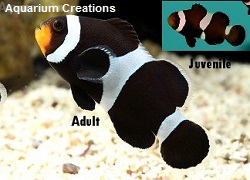
YouTube Video of Captive Bred Black & White Clownfish
Identification:The Black and White Ocellaris Clownfish, also called the Black Percula, or Black Perc is jet Black on most of its body as an adult. As a juvenile there color will be a combination of mocha and black. As the Black Ocellaris matures which occurs at around 9 to 10 months, they will get more and more black until they are totally adult looking with a jet black color. A very good candidate for a reef or fish only aquarium, they are very hardy and are perfect for the novice or seasoned aquarist. If introduced to the aquarium at the same time, many varieties of clownfish can be maintained together in the aquarium. The Black and White Ocellaris in captivity will grow to a maximum size of around 3-1/2 inches in the aquarium, and may be kept singly or in groups.
Benefits of purchasing captive bred:
The most important benefit is that by purchasing tank bred fish you are protecting
the oceans of the world from destruction. Further benefits are just as important. Tank bred fish are hardier than their wild caught counterpart and additionally
very accustomed to aquarium life and very accustomed to aquarium food.
Minimum tank size:
30 Gallon
Feeding and diet:
All clownfish are omnivores, meaning they need to eat both meaty foods along with some greens in their diet.
A high quality marine flake food, rich in spirulina and algae, as well as freeze dried and frozen foods are readily accepted and will provide the nutrition they need.
Reef Compatibility:
Excellent Reef Fish
Level of Care:
>Easy
Acclimation Time:
2+ hours
Approximate Purchase Size:
Small: 3/4" to 1-1/4" Medium: 1-1/4" to 1-3/4" Large 1-3/4" to 2-3/4"
|
Small $29.99
Medium $39.99
Large $59.99
|
Ocean Aquarium Conditioned
Black Onyx Clownfish
Amphiprion percula
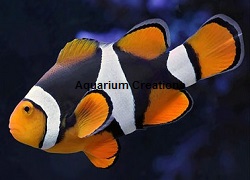
Identification:
The Black Onyx are found in the Pacific Ocean from Papua New Gunea, Northwest to Australia and Southeast to Japan. A much darker natural morph of the True Percula Clownfish the Wild Black Onyx Clownfish have a tremendous amount of Black between the stripes that continues to increase as they reach full size of approximately 3-1/2 inches in the aquarium.
Minimum tank size:
30 Gallon
Feeding and diet:
All clownfish are omnivores, meaning they need to eat both meaty foods along with some greens in their diet.
A high quality marine flake food, rich in spirulina and algae, as well as freeze dried and frozen foods are readily accepted and will provide the nutrition they need.
Reef Compatibility:
Excellent Reef Fish
Level of Care:
>Easy
Acclimation Time:
2+ hours
Approximate Purchase Size:
Large 2" to 3"
|
$89.99
|
Captive Bred
Black Onyx True Percula Clownfish
Amphiprion percula
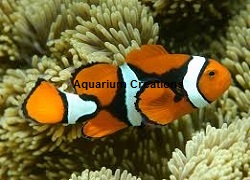
Identification:
The Black Onyx True Percula Clownfish are found on the reefs of Papua, New Guinea. They are named because of how unusually black they get between the white stripes. Fish breeding pioneer Bill Addison was responsible for bringing the purest black onyx clownfish to the hobby by selective breeding of many generations of True Percula Clownfish with the blackest markings. Expect the black color to develop more over a period of time, the older and larger
your specimen gets. Captive Bred Black Onyx Clownfish reach a maximum adult size of around 3-1/4" in size in the aquarium.
Benefits of purchasing captive bred:
The most important benefit is that by purchasing tank bred fish you are protecting
the oceans of the world from destruction. Further benefits are just as important. Tank bred fish are hardier than their wild caught counterpart and additionally
very accustomed to aquarium life and very accustomed to aquarium food.
Minimum tank size:
30 Gallon
Feeding and diet:
All clownfish are omnivores, meaning they need to eat both meaty foods along with some greens in their diet.
A high quality marine flake food, rich in spirulina and algae, as well as freeze dried and frozen foods are readily accepted and will provide the nutrition they need.
Reef Compatibility:
Excellent Reef Fish
Level of Care:
>Easy
Acclimation Time:
2+ hours
Approximate Purchase Size:
Small 1" to 1-1/2"; Medium 1-1/2" to 2"; Large 2" to 3"
Small $59.99
Medium $69.99
Large $79.99
|
|
Certified Ocean Mated Pair
Black Ocellaris Clownfish
Amphiprion ocellaris spec.
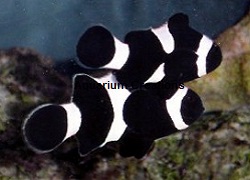
Identification:These are certified ocean mated pairs. Mated pairs of Black Ocellaris, also called Black Percula's typically spawn every 10-14 days and the eggs hatch in about 7-8 days. The female is generally the larger fish of the pair. The average nest size for Black Percula is about 250 eggs.
Minimum tank size:
30 Gallon
Feeding and diet:
All clownfish are omnivores, meaning they need to eat both meaty foods along with some greens in their diet.
A high quality marine flake food, rich in spirulina and algae, as well as freeze dried and frozen foods are readily accepted and will provide the nutrition they need.
Reef Compatibility:
Excellent Reef Fish
Level of Care:
Easy
Acclimation Time:
2+ hours
Approximate Purchase Size:
Male 1" to 1-3/4", Female 2" to 4"
|
$149.99
|
Captive Bred Pink Skunk Clownfish
Amphiprion perideraion
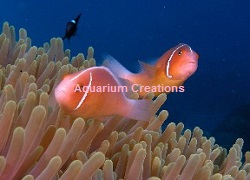
Description:
The Pink Skunk Clownfish ranges from Fiji and the Indo-Pacific to the Coral Sea.There are narrow bars on the sides of its head resembling side burns. A pinkish yellow or apricot colored fish it reaches a maximum size of 3 - 4 inches. A peaceful clownfish that can be easily kept in community or reef tanks. Breeding Pink Skunks is particularly challenging since mated pairs can take up to 5 years before spawning for the
first time. The nests can have anywhere from 800-1500 eggs. Post-metamorphic juveniles will exhibit strong schooling or "balling" behavior that will continue into adulthood.
Benefits of purchasing captive bred:
The most important benefit is that by purchasing tank bred fish you are protecting the oceans of the world from destruction. Further benefits are just as important. Tank bred fish are hardier than their wild caught counterpart and additionally very accustomed to aquarium life and very accustomed to aquarium food.
Minimum tank size:
30 Gallon
Feeding and diet:
All clownfish are omnivores, meaning they need to eat both meaty foods along with some greens in their diet.
A high quality marine flake food, rich in spirulina and algae, as well as freeze dried and frozen foods are readily accepted and will provide the nutrition they need.
Reef Compatibility:
Excellent Reef Fish
Level of Care:
Easy
Acclimation Time:
2+ hours
Approximate Purchase Size:
Small 3/4" to 1-1/4"; Medium 1-1/4" to 2"; Large 2" to 3-1/4"
Small $19.99
Medium $26.99
Large $49.99
Mated Pairs $124.99
|
|
Captive Bred Orange Skunk Clownfish
Amphiprion sandaracinos
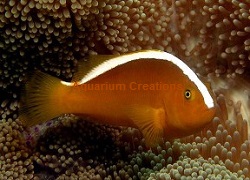
Description:
The Orange Skunk Clownfish is highly sought by aquarist's because of their unique yellow-orange color, broad white dorsal stripe, and rarity in the trade. The Orange Skunk Clownfish is one of several species of Skunk Clownfish. With a mid-dorsal white stripe, and no other head or body stripes it is easily distinguished from the Pink Skunk Clownfish (A.perideraion) that has stripes on the side of the head. The A. sandaracinos makes an ideal reef tank fish because they do not grow large, are not aggressive, and pairs easily. They are hardy in aquariums, but like many clownfish, tend to be bothered by aggressive tank mates.
Benefits of purchasing captive bred:
The most important benefit is that by purchasing tank bred fish you are protecting
the oceans of the world from destruction. Further benefits are just as important. Tank bred fish are hardier than their wild caught counterpart and additionally
very accustomed to aquarium life and very accustomed to aquarium food.
Minimum tank size:
30 Gallon
Feeding and diet:
All clownfish are omnivores, meaning they need to eat both meaty foods along with some greens in their diet.
A high quality marine flake food, rich in spirulina and algae, as well as freeze dried and frozen foods are readily accepted and will provide the nutrition they need.
Reef Compatibility:
Excellent Reef Fish
Level of Care:
Easy
Acclimation Time:
2+ hours
Approximate Purchase Size:
Small 3/4" to 1-1/4"; Medium 1-1/4" to 2"; Large 2" to 3-1/4"
Small $19.99
Medium $26.99
Large $49.99
Mated Pairs $124.99
|
|
Copyright 2020 Aquarium Creations Online
Photos are representative of each species. All marine life will be unique and variations should be expected, color and sizes may vary.
|







